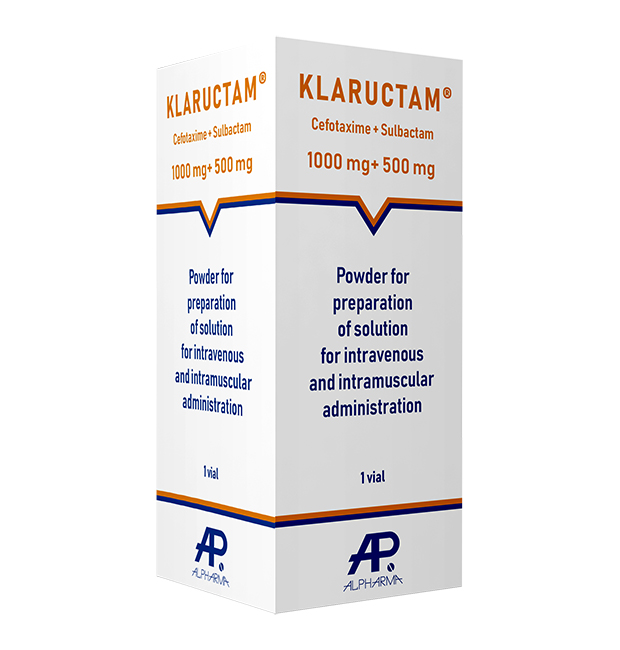Klaructam®

Klaructam® is a combination of Cefotaxime and Sulbactam for empiric treatment of community-acquired and nosocomial infections outside the ICU caused by ESBL-producers and Acinetobacter spp.
General properties of Klaructam®
- Class: inhibitor-protected III generation cephalosporin;
- Composition: cefotaxime 1000 mg + sulbactam 500 mg;
- Presentation: powder for the preparation of a solution for intravenous and intramuscular administration;
- Indications: infectious and inflammatory diseases caused by microorganisms sensitive to the combination of cefotaxime with sulbactam: infections of the central nervous system (including meningitis, excluding listeria), lower respiratory tract and ENT organs, urinary tract, bones, joints, skin and soft tissues (including infected wounds and burns), pelvic organs, gonorrhea, peritonitis, sepsis, intra-abdominal infections, endocarditis, Lyme disease (borreliosis), infections against the background of immunodeficiency. Prevention of infections after surgical operations (including urological, obstetric and gynecological, in the gastrointestinal tract;
- Shelf life: 3 years.
Marketing Authorization: ЛП-004552 dated 20.11.2017
Brief instructions for the medical use of Klaructam®
Pharmacotherapeutic group: antibiotic cephalosporin + beta-lactamase inhibitor.
Dosage form: powder for the preparation of a solution for intravenous and intramuscular administration.
Indications: infectious and inflammatory diseases caused by microorganisms sensitive to the combination of cefotaxime with sulbactam: infections of the central nervous system (including meningitis, excluding listeria), lower respiratory tract and ENT organs, urinary tract, bones, joints, skin and soft tissues (including infected wounds and burns), pelvic organs, gonorrhea, peritonitis, sepsis, intra-abdominal infections, endocarditis, Lyme disease (borreliosis), infections against the background of immunodeficiency. Prevention of infections after surgery.
Contraindications: hypersensitivity to sulbactam, cefotaxime, and other cephalosporins. For forms containing lidocaine as a solvent: hypersensitivity to lidocaine or other amide-type local anesthetic, intracardiac blockade without an established pacemaker, severe cardiac distress, intravenous administration, children under the age of 2.5 years (intramuscular administration).
Method of use: intravenously (jet, drip) and intramuscularly. The dose, method and frequency of administration should be determined by the severity of the infection, the sensitivity of the pathogen and the condition of the patient. Treatment may be started pending the results of a sensitivity test. Adults and children over 12 years old weighing 50 kg or more: for mild to moderate infections — 1 g every 12 hours.Children under 12 years old weighing up to 50 kg: the usual dose is 100-150 mg/kg/day divided into 2-4 administrations.
Newborns: the dose is 50 mg/kg per day, divided into 2-4 administrations.
Prescription status: Rx only. Shelf life: 3 years. MA: ЛП-004552.

